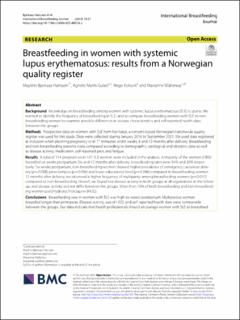| dc.description.abstract | Background
Knowledge on breastfeeding among women with systemic lupus erythematosus (SLE) is sparse. We wanted to identify the frequency of breastfeeding in SLE, and to compare breastfeeding women with SLE to non-breastfeeding women to examine possible differences in disease characteristics and self-reported health data between the groups.
Methods
Prospective data on women with SLE from RevNatus, a consent-based Norwegian nationwide quality register was used for this study. Data were collected during January 2016 to September 2021. We used data registered at inclusion when planning pregnancy or in 1st trimester, and 6 weeks, 6 and 12 months after delivery. Breastfeeding and non-breastfeeding patients were compared according to demographic, serological and obstetric data as well as disease activity, medication, self-reported pain, and fatigue.
Results
A total of 114 pregnancies in 101 SLE women were included in the analysis. A majority of the women (78%) breastfed six weeks postpartum. Six and 12 months after delivery, breastfeeding rates were 54% and 30% respectively. Six weeks postpartum, non-breastfeeding women showed higher prevalence of emergency caesarean delivery (p = 0.038), preeclampsia (p = 0.056) and lower educational level (p = 0.046) compared to breastfeeding women. 12 months after delivery, we observed a higher frequency of multiparity among breastfeeding women (p = 0.017) compared to non-breastfeeding. Overall, we found low disease activity in both groups at all registrations in the follow-up, and disease activity did not differ between the groups. More than 70% of both breastfeeding and non-breastfeeding women used hydroxychloroquine (HCQ).
Conclusions
Breastfeeding rate in women with SLE was high six weeks postpartum. Multiparous women breastfed longer than primiparas. Disease activity, use of HCQ, and self-reported health data were comparable between the groups. Our data indicate that health professionals should encourage women with SLE to breastfeed. | en_US |

